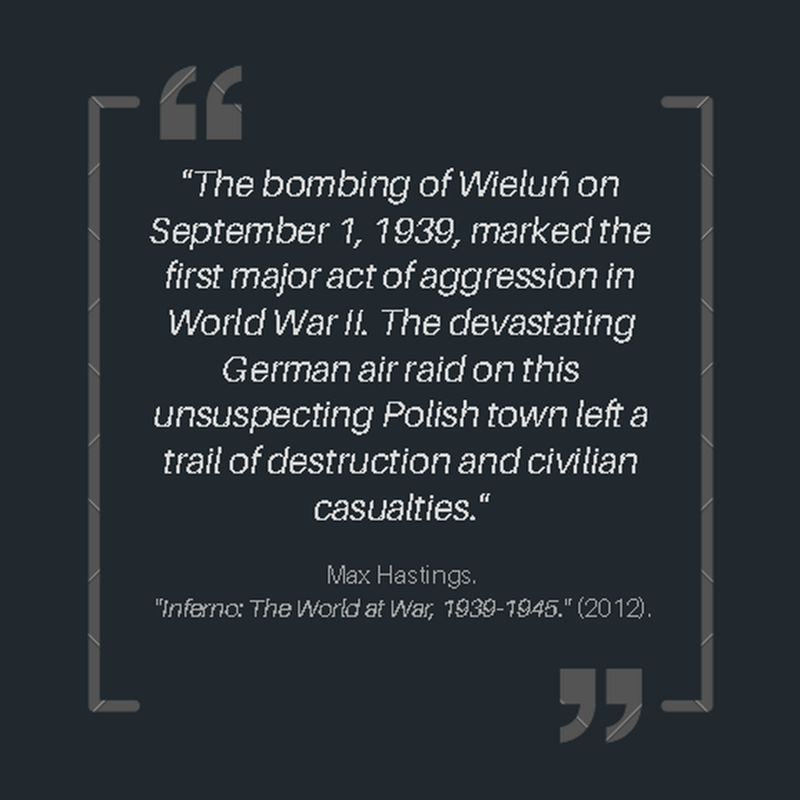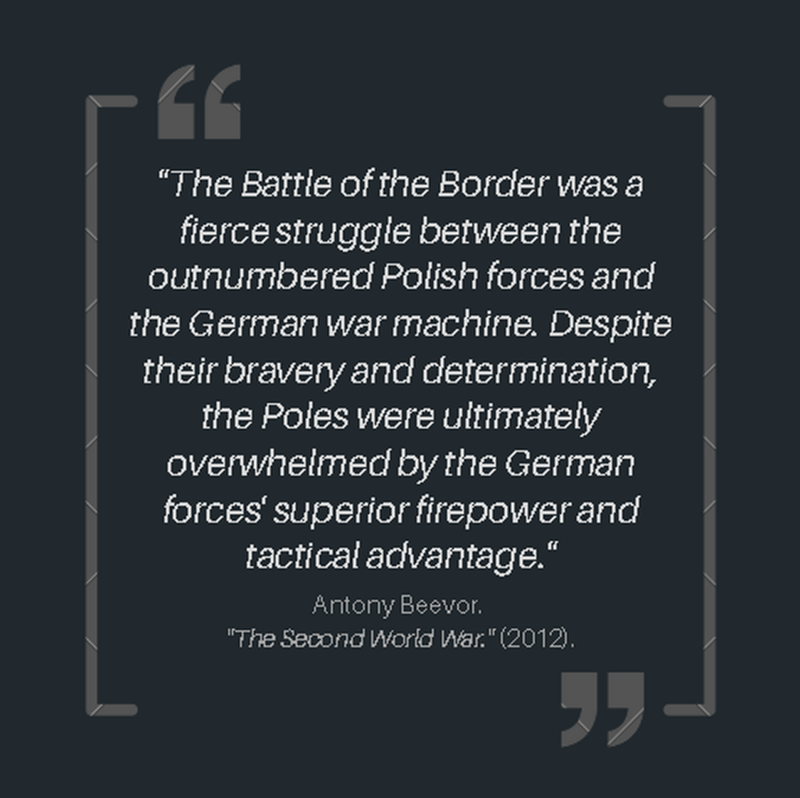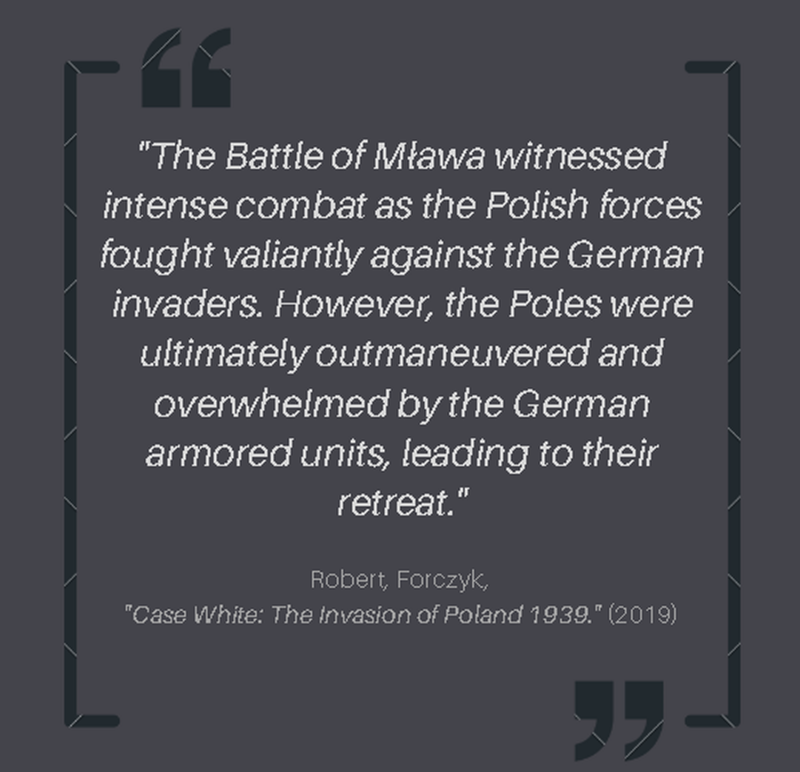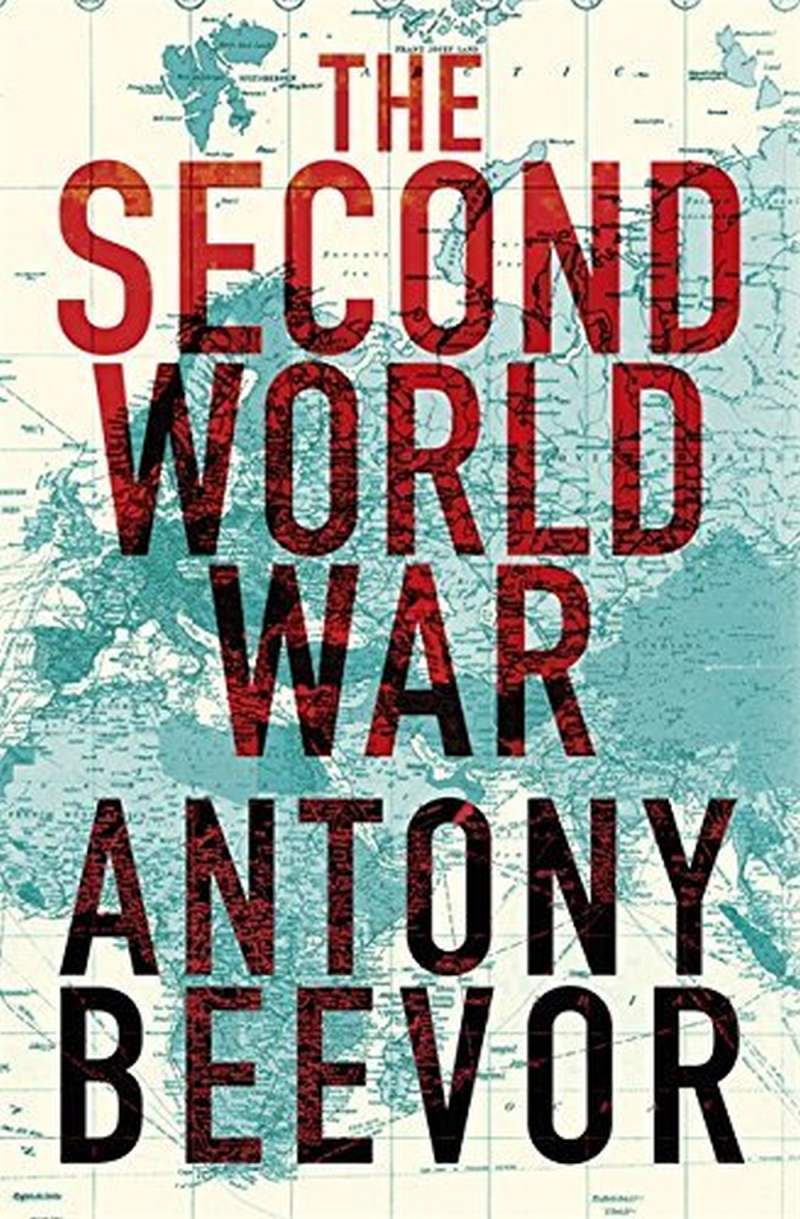Breaching the border
Poland's frontier is breached
The Battle of the Border, or Bitwa graniczna in Polish, was a series of clashes that marked the first phase of Germany's invasion of Poland in September 1939.
Though the Poles put up a valiant defence, they ultimately fell to the overwhelming might of the Germans, who succeeded in forcing them into a humiliating retreat.
Poland's defence strategy, known as Plan Zachód, was designed to protect its borders from any possible aggression by Germany.
The country's industrial and population centers were situated in the border region, particularly in Silesia, but the extensive length of the border made it exceedingly difficult to defend effectively.
While some members of the Polish military and foreign advisors criticized the plan, politicians were hesitant to abandon such a significant portion of the population to the enemy without a fight.
They were also wary of the possibility that France and the United Kingdom, Poland's allies, might not support them and could even permit the Germans to seize the coveted Polish Corridor in exchange for peace.
Made with Visme Infographic Maker
The Germans, on the other hand, had a clear and decisive plan of attack, known as Fall Weiss. They aimed to commence hostilities before officially declaring war and to employ the Blitzkrieg strategy of lightning war.
German units would invade Poland from three directions: the western Polish border, the exclave of East Prussia to the north, and the territory of Slovakia with the aid of Slovakian troops.
All three prongs of attack would converge on Warsaw, while the main Polish army would be encircled and annihilated west of the Vistula.
Poland's inferiority in terms of population and military budget compared to Germany already placed them at a disadvantage.
However, they were further hindered by their uncertainty about when the war would commence, and as a result, their armed forces were not yet fully mobilized by the 1st of September.
Polish and German forces as of 31st August and the German plan of attack.
Public Domain
The Germans invade
The SMS Schleswig-Holstein shelled Polish positions at Westerplatte, helping to start the Second World War.
The Battle of the Border commenced at the crack of dawn, as German troops flooded across multiple points of the Polish border.
The first clash of the war is often attributed to the Battle of Westerplatte, which began with the thunderous salvos of SMS Schleswig-Holstein at 04:45, though some sources contend that the bombings of Polish airfields by Luftwaffe dive bombers a few minutes prior constituted the initial act of aggression.
The Tczew bridge bombing in the Polish Corridor, executed by Sturzkampfgeschwader 1, has also been identified by several historians as the opening move of the conflict.
Meanwhile, a false flag operation known as Operation Himmler had already been underway for hours.
A Polish army battalion on manoeuvres with Swedish made Bofors 37-mm anti-tank guns during August 1939.
At 08:00 on 1 September, German forces, still without a formal declaration of war, launched an attack near the Polish town of Mokra, officially marking the beginning of the Battle of the Border.
As the day wore on, German troops advanced along Poland's western, southern, and northern borders, with German planes launching air raids on Polish cities.
The primary German assault came from the west, through the western Polish border, while a secondary route saw supporting attacks from East Prussia in the north.
A third German-Slovak joint attack, carried out by units from the territory of the German-allied Slovakia, targeted the south. All three fronts converged on the Polish capital, Warsaw.
Warsaw in the 1930's. The Polish capital was a key target for German forces.
Warsaw in the 1930s: A Look Back at Poland's Capital Just Before World War II ~ Vintage Everyday
In the northwest, the German Army Group North, led by Fedor von Bock, pushed into Pomerania and Greater Poland, striking from both Germany proper and East Prussia. In the Battle of Tuchola Forest, which lasted from 1 to 5 September, the Germans managed to divide the Polish Army
Germany artillery engaging Polish defences.
HistoryPorn (reddit.com)
Pomorze, commanded by Władysław Bortnowski, who had been charged with defending the Polish Corridor.
Though some units, like those under Admiral Józef Unrug, would continue to defend sections of the coast in battles such as Westerplatte, Gdynia, and Hel for a few more days or weeks, the rest were compelled to retreat alongside the Army Poznań under Tadeusz Kutrzeba from their positions in Greater Poland towards Kłodawa in Kujawy.
In northern Poland (Masovia), by 3 September, part of the German Third Army had vanquished the Polish Army Modlin under Emil Krukowicz-Przedrzymirski at the Battle of Mława.
The Polish troops fell back towards their backup defensive lines at the Vistula and Narew Rivers, giving the Germans a clear path towards their ultimate objective, Warsaw.
German Infantry take cover during street fighting, September 1939.
To the south and southwest, the German Army Group South, commanded by Gerd von Rundstedt, struck at the lines that separated the Polish Army Łódź, led by Juliusz Rómmel, from the Army Poznań in the north and the Army Kraków, commanded by Antoni Szylling, in the south.
Despite several tactical victories for the Polish forces, such as at the Battle of Mokra on 1st September, they were ultimately compelled to withdraw.
Army Łódź was outflanked by the German Eighth Army and the German Tenth Army, while Army Kraków retreated from Silesia, and the Army Karpaty under Kazimierz Fabrycy was gradually pushed north towards the Dunajec and Nida Rivers by the German Fourteenth Army.
By 6 September, Polish troops were in full retreat, and Marshal of Poland Edward Rydz-Śmigły issued orders for all units to fall back to the backup defensive lines at the Vistula and San Rivers.
Order of events
The Bombing of Wieluń on 1st September 1939, was the first air raid of World War II. German Luftwaffe bombers attacked the Polish town of Wieluń, killing an estimated 1,200 civilians and destroying nearly 75% of the town. The bombing was part of the German Invasion of Poland and marked the beginning of the war in Europe.
The Battle of Chojnice was fought on 1st September 1939, between German and Polish forces during the early stages of the German Invasion of Poland. The outnumbered Polish defenders fought bravely but were eventually overwhelmed by the superior firepower of the Germans. The battle resulted in the capture of the town of Chojnice by the Wehrmacht.
The Charge at Krojanty was a cavalry charge that took place on 1st September 1939, during the German Invasion of Poland. Polish cavalry units, under the command of Major Henryk Dobrzański, charged at German infantry positions near the village of Krojanty. The charge became a symbol of Polish courage and sacrifice during the war (although a myth also spread that Polish Cavalry had bravely charged German tanks – however, none were present at the battle.)

German troops at the Battle of Chojnice.
History of Chojnice - Chojnice during the Nazi occupation 1939 - 1945 (photo video) (bprk.pl)
The Battle of Lasy Królewskie took place during the German invasion of Poland in 1939. Polish forces, heavily outnumbered, defended the Royal Forest against the advancing German army. Despite their valiant efforts, the Poles were eventually overwhelmed, leading to the fall of Lasy Królewskie and further German advances into Poland.
The 1st September 1939 saw the Battle of Mokra take place - was a significant engagement during the German invasion of Poland in 1939. Polish armoured units, with effective use of anti-tank weaponry, ambushed the German 4th Panzer Division, inflicting heavy losses and disrupting their advance. The Polish victory delayed the German offensive and demonstrated their armoured warfare capabilities.
The Battle of Pszczyna occurred during the German invasion of Poland from the 1st to the 2nd September, 1939. Polish forces fiercely defended the town of Pszczyna against the German 10th Infantry Division, inflicting heavy casualties and delaying the German advance. Despite their bravery, the Polish defenders were eventually forced to withdraw due to overwhelming German firepower.
The Battle of Mława on the 1st – 3rd September was a major conflict during the German invasion of Poland in 1939. Polish forces, commanded by General Władysław Bortnowski, successfully repelled the German 3rd Army, inflicting heavy casualties and disrupting their offensive. The battle showcased Polish resilience and tactical proficiency but ultimately ended in a German victory.
The Battle of Grudziądz on the 1st to 4th September 1939 was a significant engagement during the German invasion of Poland. Polish forces, defending the city of Grudziądz, resisted the German attack for several days, inflicting heavy losses. However, overwhelmed by superior German firepower, the Polish defenders were eventually forced to surrender, marking a German victory.
The Battle of Przasnysz and Ciechanów was a series of engagements from the 1st to the 4th September during the German invasion. Polish forces put up fierce resistance in the towns of Przasnysz and Ciechanów, inflicting heavy casualties on the German forces. However, the overwhelming German firepower eventually led to the capture of both towns, solidifying a German victory.
The Battle of Jordanów was a notable conflict during the German invasion of Poland in from the 1st – 3rd September 1939. Polish forces, defending the town of Jordanów, fiercely resisted the German advance, inflicting significant casualties. Despite their valiant efforts, the Polish defenders were eventually overwhelmed by the superior German forces, resulting in a German victory.
The Battle of Góra Kamienska was a significant engagement during the German invasion of Poland o the 2nd September 1939. Polish forces, defending the strategic position of Góra Kamienska, fiercely resisted the German attack. Despite putting up a strong defence, the Polish defenders were eventually forced to withdraw due to overwhelming German firepower, resulting in a German victory.
The Raid on Fraustadt on the 2nd September occurred when German forces launched a swift assault on the town of Fraustadt, overwhelming Polish defences. The raid resulted in the capture of the town and further consolidation of German control in the region.
The Battle of Węgierska Górka (1st – 3rd September 1939) was a significant engagement during the German invasion of Poland. Polish forces, defending the strategic town of Węgierska Górka, fiercely resisted the German advance. Despite valiant efforts, the Poles were eventually overwhelmed by superior German firepower, leading to the German capture of the town.
The Battle of Częstochowa was a major conflict during the German invasion of Poland from 1st – 4th September 1939. Polish forces, defending the city of Częstochowa and its iconic Jasna Góra monastery, put up a determined resistance against the German onslaught. Despite heavy fighting, the Polish defenders were eventually overrun by superior German forces.
The Battle of Tuchola Forest was a significant engagement during the German invasion of Poland, 1st – 5th September 1939. Polish forces, utilizing the dense forest as cover, engaged in guerrilla warfare against the advancing German army. Despite their tactics, the Polish defenders were eventually outmatched and forced to retreat, marking a German victory.
Battle of Borowa Góra from the 2nd to 5th September was a significant engagement fought during the Invasion of Poland. German forces attacked Polish defenses on Borowa Góra hill, leading to heavy casualties on both sides. The battle ended with a German victory, furthering their advance into Poland.
Battle of Częstochowa (1st – 4th September 1939) took place during the German invasion of Poland which saw Polish forces defend the city against the German Wehrmacht. Despite putting up a determined resistance, the Polish defenders eventually succumbed to overwhelming German firepower, resulting in the capture of Częstochowa.
The Battle of Mikołów, a lesser known yet significant border engagement, unfolded on September 1 and 2, 1939, in the Silesian Voivodeship. It marked a crucial moment during the initial stages of the German Invasion of Poland in the Second World War. Fought in the vicinity of Mikołów, the battle showcased the intense struggle for control and set the tone for the ensuing conflict.
The Defence of Katowice in 3rd – 4th September 1939 was a fierce resistance effort during the German invasion of Poland. Polish forces put up a valiant fight to defend the city but faced overwhelming odds. Eventually, Katowice fell to German control, marking a significant moment in the early stages of the Second World War.
The Battle of Bukowiec on the 3rd of September 1939 was a crucial engagement during the German invasion of Poland. Polish forces fiercely defended the strategic position of Bukowiec against the advancing German army. Despite their brave resistance, the overwhelming German forces ultimately prevailed, leading to the fall of Bukowiec and further German advancement.
The Slovak Invasion – 1st – 16th September 1939 refers to the military operation conducted by Nazi Germany to facilitate the establishment of the puppet state of Slovakia. German forces coordinated with Slovak nationalists to topple the Czechoslovak government and pave the way for the creation of an independent pro-German regime in Slovakia.
Aftermath
The Battle of the Border, save for a few notable exceptions, saw the swift and overwhelming defeat of Polish forces. Pomerania, Greater Poland, and Silesia all fell to the enemy, leaving the Polish military with little choice but to retreat. The quick succession of these defeats made it increasingly challenging for the Polish forces to stage an organized retreat to their secondary lines of defense behind the Vistula and near the Romanian Bridgehead.
Despite their valiant efforts, the Poles were outmatched and outgunned by the German onslaught, which swept through the country with ease, leaving a trail of destruction in its wake. The Battles of Hel and Mokra were minor bright spots for the Polish defenders, but they ultimately proved insufficient to halt the German advance. The Battle of the Border was a brutal affair that saw Poland suffer a grievous blow, one that it would never fully recover from.
Further reading
Wikipedia
(7) German soldiers at the beginning of the Polenfeldzug (invasion of Poland), 1939. [1080x1298] : HistoryPorn (reddit.com)
https://www.facebook.com/worldwarincolor/photos/a.393169424146189/4874477766015310/
Doug
Warsaw in the 1930s: A Look Back at Poland's Capital Just Before World War II ~ Vintage Everyday
















